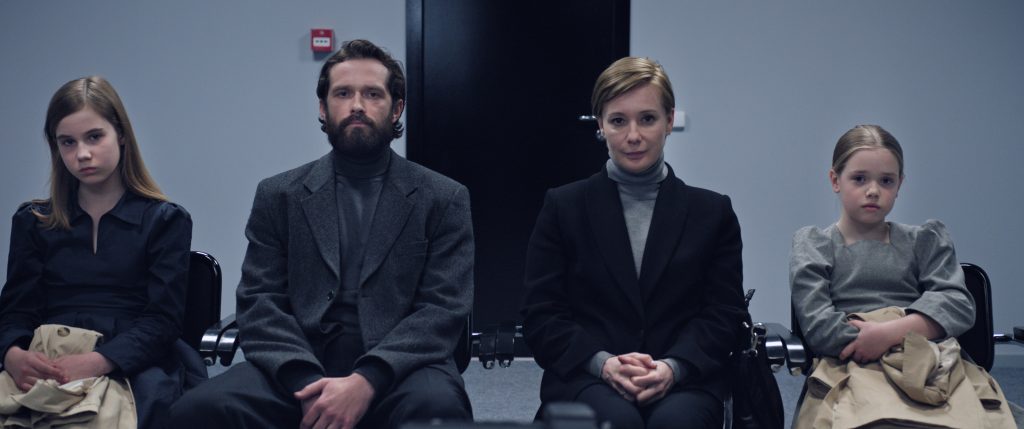News about art and medicine
This section, edited by Henk Maassen, features reviews of current novels, films, music, theater, exhibitions and poetry in which medicine plays a role every two weeks on Saturdays. But, since we are a Dutch side in origin, films will probably be the main topic in the English version of Scoop. Comments, questions, tips, criticism, and praise can be sent to Henk Maassen: scoop0329@gmail.com
Scoop 11: September 20, 2025
Four films and a novel this time. A breathtaking film (Heldin) about the workload of a nurse, two films (The Blue Trail and Familiar Touch) about aging, with or without disabilities, and finally a crazy film about a man with brain damage (El Jockey). And an encouragement to read Ian McEwan’s new novel (What We Know), because it deals with many topics, but especially the impact of dementia.
Here you will find the PDF of this episode of Scoop.
Film
Heldin, now showing in theaters

Nurse races against the clock
In her recent book Dit kost ons de zorg (This is what healthcare costs us), general practitioner and publicist Danka Stuijver tells the story of a nurse who comes to her office complaining that she “can’t take it anymore.” She is only in her mid-forties, but now that two of the eight permanent colleagues with whom she had to fill the gaps in the schedule have left the healthcare sector, she has had enough. She can’t do it anymore. Stuijver writes that she is not so much shocked by her words as by the resigned tone in which the nurse speaks: ‘She no longer has any hope for improvement. ‘
Her story is one of many, according to Stuijver, and it wouldn’t take much for Floria, the nurse we follow in Heldin by Petra Volpe, to become one of them. Despite the understaffing of her late shift, Floria does her job professionally and with dedication. She is professional, juggles many tasks, and is concerned with the ups and downs of her 26 patients, such as the old man who anxiously awaits his diagnosis while the doctor in charge is too busy to report in, the difficult sons of a terminally ill woman, and a young mother who has cancer. And then there is also an insecure intern and a haughty, unhappy but terminally ill patient with private insurance (we are in Switzerland) who initially gets on Floria’s nerves with his futile wishes.
Floria’s routine, which is hectic enough in itself, is constantly interrupted by matters that require her urgent attention. As her shift progresses, her work increasingly becomes a race against the clock, and in the meantime she struggles with the fact that she neglects the patients who bother her the least. Someone dies, and she initially overlooks an allergic reaction to incorrect medication. Fortunately, things also go well, such as her touching conversation with the terminally ill mother. The hectic pace culminates in a brief outburst of anger when the demanding terminally ill man becomes too much for her: she throws his expensive watch out of the window. Later, she tries to find the watch in the bushes, as if she were searching for ‘lost time’ – a perhaps overly symbolic action in a film that relies primarily on reality rather than metaphors. Because the level of realism is high: in preparation, filmmaker Petra Volpe shadowed nurses in various Swiss hospitals and also enlisted a nursing specialist as an advisor. Lead actress Leonie Benesch even did an internship in a hospital.
In long, often uninterrupted shots, we follow Floria as she does her thousand and one tasks. Only afterwards does the viewer realize that Heroine lasted only an hour and a half, while her shift obviously took many more hours. With this, Leonie Benesch—the film is consistently told from her perspective, so she can be seen in every scene—and writer/director Petra Volpe deliver a major achievement.
The closing credits of this film emphasize that the shortage of nursing staff is a global problem and will only get worse. By 2030, Switzerland will be short
30,000 nurses, and according to the WHO, the global shortage will be as high as 13 million.
Henk Maassen
Film
The Blue Trail, now in theaters, and from October 2 also available on picl.nl

Familiar Touch, in theaters from September 25
The coming of old age film: a new genre?
Two recent films shed new light on the experience of aging, each in its own way. While Gabriel Mascaro’s Brazilian film The Blue Trail focuses on the struggle for autonomy, Sarah Friedland’s American film Familiar Touch opts for an intimate exploration of dementia from the perspective of the main character. Both films break with conventional storylines and approach old age, with or without its shortcomings, as a rite of passage, comparable to coming of age.
The Blue Trail centers on Tereza, a 77-year-old woman from an industrial town on the edge of the Amazon region. She works as a cleaner in a crocodile slaughterhouse. But as a person over 75, the state claims her house, she is awarded a medal as ‘national heritage’, assigned a guardian—her daughter, who has no time for her—and put on a bus to a ‘senior colony’ with a backpack and an incontinence diaper, which she refuses to wear. These colonies are intended to allow the elderly to ‘enjoy’ their final years in a secluded place, so that the younger generation can focus entirely on growth and productivity. Those who refuse are tracked down and taken away in cages.
However, Tereza decides not to accept this imposed final phase of life and embarks on a clandestine boat trip through the Amazon, which turns out to be a journey full of obstacles, encounters, and discoveries. For her, there will be no “social euthanasia,” as director Mascaro called it in an interview.

In Familiar Touch by Sarah Friedland, Ruth, who is over 80, leads a seemingly quiet life, but her memory is increasingly failing her. She makes small mistakes in her daily routine. When she confuses her son with an admirer, it marks the beginning of an irreversible change. When Ruth ends up in a nursing home—a decision she cannot remember making—she feels lost among the other residents. She doesn’t belong there, she thinks.
What both films share is that the stories of Tereza and Ruth (both played by wonderful actresses) are not told through the eyes of children, partners, or caregivers, but show how both women themselves experience what it is like to grow older. The Blue Trail does this through an adventurous, unpredictable, and visually appealing journey through the Amazon region; Familiar Touch through a tranquil but equally transformative inner journey, in equally beautifully composed shots.
Both filmmakers thus refer explicitly to the coming-of-age genre. Just as adolescents form their identities, Ruth and Tereza must reorient themselves to a changing reality, shake off their social roles, and find a new balance. Sometimes playful and cheerful, sometimes with heartache and sadness.
Henk Maassen
Novel
What Can We Know, Ian McEwan. London: Jonathan Cape, 2025.

The impact of dementia
Much has already been written about What We Can Know by Ian McEwan; the book is on the bestseller list, so why focus on it here? Quite simply because it is also, or perhaps even primarily, a book about the impact of dementia. It begins as a quest in the year 2119 to find a long-lost but now legendary poem by the renowned Francis Blundy, which he recited during a dinner in 2014 for the 54th birthday of his wife Vivien. Before Vivien had an affair with Blundy, she was married to the violin maker Percy Greene, who developed early Alzheimer’s. He died shortly before he was to be admitted to a nursing home.
Clever, as we have come to expect from McEwan, he intertwines a whole series of motifs – although not always very tightly, but so be it. Such as the decline of the climate: in 2119, the world is in chaos. England is an archipelago, cities have sunk, the global economy has collapsed. But also: the shrinking field of the humanities, the problematic nature of biography and, in light of that, the biographical interpretation of art, and more generally: the relationship between memory and truth, and that between art and reality. The latter is beautifully illustrated in the contrast between the intellectual poet Francis Blundy, who has no interest in nature, and the tough craftsman Percy Greene (what’s in a name), who takes pleasure in manual labor and his knowledge of nature: a “nature man,” a man of integrity. Here, we recognize the contrast from McEwan’s earlier novel Saturday between the neurosurgeon Henry Perowne, who has no need for literature and imagination to know anything meaningful about the human condition, and his father-in-law, the great poet John Grammaticus (again: what’s in a name).
In a short, almost casual passage in What We Know, we read that the imagined is stronger than the factual: ‘The characters we cherish in literature do not really exist. As individuals or countries, we embellish our history so that we come across better than we really are. We live our lives based on assumptions that are not further investigated or contradicted and populate a nebula of dreams that we seem to need.’
This will prove to be a crucial statement, because that ‘mist of dreams’ is dispelled in the second part of the book. It would be a shame to reveal the how and why here, as it would be a spoiler. But the main thing is that this brings another important theme to light: steadfast love in times of mental decline. “Watching the person you love gradually succumb to merciless disintegration should have been both dark and grand, even dramatic. But the daily reality of the decline consisted of its banalities.” The way in which McEwan then gives words, or rather substance, to Vivien’s great love for Percy is unparalleled.
Henk Maassen
Film
El Jockey, now showing in theaters and via picl.nl

How a blow to the head changes the world
It quickly becomes clear that El Jockey is no ordinary film. The opening scene, a café populated by men who all have serious physical disabilities, immediately sets the absurdist tone. Later, we see how jockeys prepare for a horse race by performing a kind of dance. And the abrupt way in which scenes follow each other is also quite unsettling, especially at first.
The story, insofar as there is one: Remo Manfredini was once a successful jockey, but his self-destructive behavior led him astray. Now he races mainly to pay off his sky-high debts to a criminal gang led by a shady mafia boss, who, incidentally, always carries a baby with him whenever he is on screen—yet another unsettling detail. During the most important race of his life, things go wrong: Remo causes a tragic accident in which one of the most valuable horses is killed. He himself is seriously injured in the head.
The attending neurologist has bad news: recovery is impossible, Remo will have to learn to live with severe limitations. But Remo, who is anything but himself, doesn’t care, steals a patient’s fur coat and handbag, leaves the hospital, and wanders the streets, no longer sure who he is or was. “His injury seems to have left him lost in space and time,” suggests a police officer who is following him via the city’s security cameras. When Remo steps on a scale at a drugstore, he weighs exactly 1 gram… Are we wandering around in his comatose mind? What or who is he actually: woman, man, ghost? Has he ended up in a kind of purgatory?
Creator Luis Ortega has said: “One day we wake up and we are a man. Another day we wake up and we are a woman. Another day, a child. (…) But the real challenge for my main character is not to go crazy.”
That may also apply to the viewer. But anyone with a sense of the absurd, the magical-realistic, and the fantastic, all told with a kind of deadpan humor, will have a fun evening. What is it ultimately about? Well, can you ever know with a surrealist?
Henk Maassen
SCOOP 10: September 6, 2025
This edition features a powerful Georgian film about a gynecologist in trouble and a French classic from the early 1960s about a young woman who wanders through Paris while waiting for the potentially serious results of her medical examination.
Here you will find the PDF of this edition.
Film
April, now in theaters
Gynecologist between law and personal morality

Nina is known as an excellent gynecologist, but she jeopardizes her “reputation” by performing illegal abortions and providing women with contraceptives in rural East Georgia, with its oppressive patriarchal culture. She herself leads a routine, socially isolated existence and keeps others, including her ex and colleague, at a distance. Meanwhile, she has risky, anonymous sex with men she picks up along country roads. When a newborn under her care dies, she is accused of negligence; she should have performed a caesarean section. And when a deaf-mute girl is murdered and found to have had an abortion, Nina faces a second abyss. But by then we are already nearing the end of the extremely intense April, Déa Kulumbegashvili’s second film.
Told in this way, April seems like a conventional film. Nothing could be further from the truth: Kulumbegashvili takes a more original approach. Her film is characterized by long silences and long takes. She often films events in real time. She records births in a documentary style. Nevertheless, she rehearsed with body doubles so that she and her amazing cinematographer Arseni Khachaturan knew what to do when a real birth began. And that is captured in your face, just like an oppressive abortion. Kulumbegashvili’s mise en scene is extremely effective and ‘gets inside’ the viewer. This is mainly due to the way she suggests subjectivity: with Matthew Herbert’s grinding, creaking music, for example, with the whispering, the sound of car tires, wind, and rain—all meticulously captured and edited. Paradoxically, this makes all her scenes seem “real” and at the same time extremely concentrated and controlled.
The best example: halfway through the film, a thunderstorm breaks out. In camera and editing, the filmmaker lets nature do its work in a beautiful 180-degree camera movement. Yet the image is staged: at the far edge of the shot, a car – later revealed to be Nina’s – gets stuck in the mud. And it is precisely that mud that played a decisive role in Nina’s past and probably made her who she is today to a large extent. Fiction and reality merge, as they always do in this film.
The opening of the film is intense: we see a terrifying Francis Bacon-like creature, unearthly and human at the same time. A faceless, aged body against a dark background with children playing and rain, accompanied by heavy breathing on the soundtrack. The creature appears regularly. The suggestion is that it is Nina herself. Is it the representation of her inner self? Of a transition she is going through?
Kulumbegashvili knows the area where her film is set well. She grew up there and spent a considerable amount of time in maternity clinics during the preparation phase. There she saw how pregnant women often came to consultations with their mothers. And that most of them already had six or seven children and often could neither read nor write.
This part of Georgia is an area, says one of the characters in April, “without asphalt and without paved roads.” Nina has to navigate this as a doctor, juggling the prevailing patriarchy and the law on the one hand and her professional and personal morals on the other. Should she have performed the caesarean section after all? No, she thinks, because she had to act quickly, the mother was strongly opposed to the procedure and was not known to the hospital, so there was no information about the condition of the mother and child.
At the end of the film, the pathologist gives a dry, lengthy summary of what was wrong with the stillborn child, a summary that is only understandable to doctors. The hospital’s chief physician then observes, more generally than referring to this specific case: “Perhaps God sends us hardships so that we learn to deal with despair.”
The question remains as to why the film is titled April. Is Kulumbegashvili perhaps referring to the famous opening lines of T.S. Eliot’s renowned Waste Land? “April is the cruelest month, breeding/lilacs out of the dead land, mixing/memory and desire, stirring/dull roots with spring rain.” Judging by what we see, I would say yes.
Henk Maassen
Film
Cléo de 5 à 7, back in theaters

Waiting for the results, between hope and fear
As part of a small retrospective dedicated to the great French director Agnès Varda (1928-2019), her classic Cléo de 5 à 7 (1962) is back in theaters. In this black-and-white production, we follow Cléo, a popular chansonnière, during the longest two hours of her life (from 5 to 7 in the afternoon). Two days earlier, she underwent some tests because of abdominal pain. She will receive the results at 6:30. In the film, we are with her for an hour and a half. Her own premonition, plus the prediction of a fortune teller right at the beginning of the film, do not bode well: she fears she has cancer.
Floating between hope and fear, she walks through the busy streets of Paris. The relatively restless camera—we are used to this nowadays, but in 1962 when the film was released, it was new!—seems like an independent eye that happened to catch sight of Cléo and is now following her closely. We walk with her on her odyssey from the Rue de Rivoli to the Salpetrière Hospital. And we witness her encounters in a café, a taxi ride, a visit to her apartment, and a trip to the cinema.
The objectively verifiable clock time (the film is divided into thirteen episodes) is thus suggestively contrasted with Cléo’s subjective experience of time. This makes the film less a story and more a nervous experience of time – until the moment Cléo receives the results of her medical tests.
Meanwhile, she tries to dispel any thoughts of possible physical decline and death. She thinks of the joys of her existence: ‘(…) les vacances, le reste c’est n’importe quoi.’ The world imposes itself on her, but she does not react. Neither to disturbing news on the car radio about the explosive situation in what was then French Algeria, nor to the reflection in a shop window of soldiers on their way to this colonial theater of war. Cléo is only interested in what is displayed in the shop window.
Towards the end of the film, she meets a soldier who is returning to the battle in Algeria. He convinces her that love can even take away the fear of death.
Spoiler (!): The doctor finally tells her that she does indeed have cancer, but that the disease may be curable. “Maybe I feel happy now,” she concludes. We don’t find out what she does next. If she doesn’t recover (and she won’t; Agnés Varda notes rather bluntly in her script: “Jeune femme blessé, sans doute promise à la mort.”), if her time is limited, what will her life look like? It is as if the film continues after the lights come on in the theater.
Henk Maassen
Scoop 9 August 23 2025
This edition features a beautiful collection of stories that gives us a glimpse into how children deal with illness and crises in the family and a—unfortunately—failed film about exploring the boundary between mental illness and spirituality.
You can find this edition here: pdf.
Collection of stories
The Story of Mrs. Berg, Ingvild H. Rishøi (not translated into English)
How illness disrupts children in the family
Five beautiful stories comprise The Story of Mrs. Berg by Norwegian author Ingvild H. Rishøi (1978). They are all descents into the soul of a child, and for that reason alone, this is a collection that no one involved in caring for children should miss. Stories about meeting your first love, discovering that you look a lot like Janis Joplin, or about the love for a hamster named Mrs. Berg. They are all about (growing up) children. And there is always disruption in their families due to (mental) illness and the children’s reactions to it. Making people disappear, for example, is a collection of short, fragmentary memories of two sisters, in which the younger sister is suddenly taken to hospital, leaving her older sister distraught. In the title story, a young girl tells how she has been given a hamster and how, since her parents’ divorce, she lives alternately with her father and mother. Her mother is clearly in mental distress, which has disastrous consequences for the hamster, and therefore for the girl, which she notes with half-understanding.
This quote beautifully illustrates how Rishøi uses the girl’s stream of words to give us a glimpse into her associative thoughts and feelings, including her compulsive ‘counting’ to keep intrusive thoughts of doom at bay. The girl has just received the hamster as a gift: ‘That day I taught her to walk through toilet rolls, and I just forgot where I was and who I was: Emilie. A hamster is different from a cat. It tickled when she ran across my arm. She was so small, when she sat in my hand I felt I could crush her if I squeezed my hand or hit her with a big book. It kept raining outside, the window was soaking wet. But the light from the ceiling lamp was a beautiful yellow. And I had become a different girl. Then she ran through the toilet roll. That was the best day ever. But why does it always have to be like this? Always the best and the worst, over and over again. Because it smelled really bad. Oh, the worst. Because the next time I came, I put my bag away and went to my room. Thirty, twenty-nine, twenty-eight. Take those stupid thoughts away from me.
Rishøi’s style is stripped down, simple, sometimes like a children’s book or a fairy tale. Some of the images allude to this: a wolf, glow worms, the healing, almost magical effect of the color white. Her characters register. Their psychology or the drama in which they appear is emergent, emerging from what they see, experience, and tell. Much of the drama takes place between the lines. In That Which Gives Light, the younger of two brothers tells how he looks up to his older brother Richard, his mentor in life. And how things go completely wrong during Richard’s adolescence, and he is no longer able to connect with him. Richard no longer wants to go to school, and later he doesn’t even leave his room: ‘I understand what’s going on, there are voices in his head, they scare him and they scare me too. I go to school and feel my body tingling because Richard doesn’t talk to me anymore. He taught me everything, about space and multiplication tables, where our forest is sacred, which feathers belong to falcons, he taught me everything, but now everything is different. My brother doesn’t want to talk to me anymore. I go to school and there’s a cold wind. I put my hood up at the mailboxes, the puddles are frozen, I can’t believe it was ever summer.
My Girls is an exception: this heartbreaking story is told by a father who hasn’t seen his eldest daughter in years. He fantasizes about how her life might have turned out. When his wife was pregnant for the second time, she fell ill—a doctor attributed it to “the hormones.” Around that time, a woman named Katja, a Lolita-esque type with philosophical tendencies, comes into his life. She strikes a chord with him and turns his head, or perhaps his soul. Then things gradually go wrong between him, his wife, and his eldest daughter: “I didn’t know then what I know now. How fate works—it catches you and throws you down somewhere. You have to think about everything you do. But you know, you never have enough time to think. Life catches up with you all the time.“
Perhaps that is the crux of these incomparable stories. The father in ”My Girls“ later explains it to himself as a simple, banal fact of life: ”It was evening, because it always is. Everything goes on, you know, people and the world and the day, they don’t care about you. But I had groceries with me, and I had another daughter I couldn’t forget. I never came home that late. (…) I remember the way home. I took the subway. I looked at everything and understood everything: everything just goes on. Whether you die or your whole life goes to hell: the news comes on the radio every hour and the subway keeps running.’ The point is: all the children in these stories, no matter how young they are, have similar formative experiences, but they are unconscious and unspoken.
And I haven’t even mentioned the most beautiful story: ‘The Life and Death of Janis Joplin’. That alone makes this book worth buying.
Henk Maassen
Film
The Ritual, now in theaters
On the border between faith and medical science
Thanks to the use of handheld camera work, sober colors, and shock effects through sound design instead of grotesque visual horror, The Ritual, about a “possessed” young woman, initially makes an authentic, almost documentary impression.
The story is based on a notorious ‘real’ case: in 1928, a Capuchin monk was called upon to free a young woman, Emma Schmidt, from possible demonic possession. The skeptical priest Joseph Steiger documented the case. At the time, doctors and psychiatrists were unable to explain or treat her behavior, which is hardly surprising given all the levitations, demonic voices, and supernatural manifestations.
The film’s director, David Midell, had previously worked as a therapist and had, one assumes, good intentions. He claims to have spent ‘thousands of hours’ researching the facts, history, and context of this case. In his film, everything had to add up. Especially because he wanted to explore the boundary between mental health and spiritual experience: ‘Some have described exorcisms as Rorschach tests: those with a background in faith and religion see a spiritual battle for a person’s soul, while those who are more scientifically minded see that a person needs psychiatric help.’
Well, if Midell had stuck to the facts, this might have been an interesting docudrama and viewers could have subjected themselves to a valid test on the issue of (medical) science versus faith. But then again, that’s not what you usually get at the cinema. In the end, Midell gets bogged down in the kind of clichés that true horror fans have seen so many times before, and in infinitely better productions (The Exorcist!). The fact that Al Pacino took on the role of the Capuchin monk in his old age raises the question of what could have made him think this would be a good movie. Was it the director’s thorough research?
Henk Maassen
Scoop 8: August 9, 2025
This edition features one recent novel. A Simple Procedure is about a surgical procedure that can put an end to mental disorders—where have we heard that before? We also focus on a masterful, unmissable documentary trilogy about the reception and care of psychiatric patients in Paris.
Here you can find the PDF of this edition.
Comments, questions, tips, criticism, and praise can be sent to: scoop0329@gmail.com
Novel
A Simple Procedure, Yael Inokai,. (Original language: German, not translated into English)
A surgical dystopia

“At the time,” Meret says at the beginning of A Simple Procedure by Swiss author Yael Inokai, “I was a nurse in a hospital where new procedures were being performed. These procedures were supposed to free people from their mental illnesses and give them a new future, a real future, not just survival.” She was in her mid-twenties at the time and believed that the brain was like a map: “Everything I am is located somewhere.” This included any disorders and conditions, no matter how trivial, such as regular anger attacks. Her job was to distract patients—mostly women—during the surgical procedure, which was performed while they were fully conscious.
Inevitably, things sometimes go wrong, the surgeon confided to her, because: “Progress can be painful. Things get better, but first they get worse. That’s just the way it is.” Meret realizes: “The after-effects could be painful, but they passed. Then something new began. That’s what I was taught. That’s what I held on to.”
In addition to Meret, the novel focuses on three other women: her roommate and colleague Sarah, with whom Meret falls passionately in love; the fortunes of Bibi, Meret’s free-spirited sister and, in that respect, her complete opposite; and the case of Marianne, whose operation goes wrong.
Meret takes her under her wing – at first purely professionally, later as a concerned friend. Inokai leaves out the ‘at the time’ from the opening of her story and does not mention where it takes place. The atmosphere and manners suggest the early 1950s.
There are hints of lobotomy. The hierarchy between doctors, nurses, and (female) patients seems set in stone. Male doctors rule over female nurses. Nurses disapprove of compassion for patients, adhering strictly to rules, guidelines, and routines.
One is tempted to say that the work is carried out with merciless Swiss (or German?) precision.
Inokai’s style is sober and the construction of her novel—call it a Margaret Atwood-esque dystopia—is as inventive as it is effective. Moreover, she does not unnecessarily emphasize her well-considered themes. Sometimes you have to read between the lines. For example, one of the doctors tells Meret that people are punished for their appearance and their illnesses. “You and I have a duty to protect people from punishment. That’s a bold statement, I know. There’s a lot to be said for the intervention, and I see that as part of it.”
What is disturbing is that he is driven by an even deeper, much darker motivation: ‘What do you think will happen if things go back to the way they were? Suppose it only gets a little bit bad. That’s enough. Then they’ll say, “So-and-so can live, but so-and-so can’t.” You and I know very well that this is always a possibility. Things become… fragile. I’ve learned that during my life.“ In short: progress is not only halting and uneven, it is apparently also ”intended” to prevent worse things from happening.
When Meret runs into a former patient who seems to have lost all her vitality after the operation, her doubts about the procedure grow. She already had doubts about her beloved Sarah: “Wouldn’t they say that about us? That it’s a mental illness?” Meret has always been guided by the assumption that medicine stands “on the shoulders of hope.” “I had to keep that alive, no matter how hopeless the situation was.”
How she does that and ultimately ‘saves’ Marianne, whose operation went wrong, will remain a mystery here. Suffice it to say that Yael Inokai’s award-winning novel has made a big impression in German-speaking countries.
Henk Maassen
Film
La machine à écrire and Averroès & Rosa Parks, (French language)
Together with Sur l’Adamant, these films can also be seen via picl.nl
Triptych about vulnerable individuals
First, in 2023, there was the brilliant documentary Sur l’Adamant, made by Nicolas Philibert, known for the equally magnificent Être et Avoir about a rural school in France. Sur l’Adamant is an impressive portrait of a handful of psychiatric patients who find a safe haven on an ark on the Seine. With music workshops and drawing studios, culture is central to life on the ship. Because culture makes life worth living. One of the clients talks about his artistic affinity with Vincent van Gogh. Another responds to the question of whether he has a profession: “No. Poetry, but that’s not a profession.” Yet another explains how science fiction, comics, and pop music keep him going.
Sur l’Adamant, it turns out, is the first part of a trilogy. The other two parts are now coming to the cinema: La machine à écrire and Averroès & Rosa Parks. In La machine à écrire, Philibert visits some of the people we know from Sur l’Adamant. He films them at home as volunteers come to repair a broken appliance or help with another household problem. Philibert situates them in their environment and occasionally asks them a question. In this way, he makes it clear how essential this simple help is for these people.
In Averroès & Rosa Parks, two wards of the Esquirol hospital in Paris, he recorded a series of conversations between clients and care workers. This format makes the tone of this long documentary (but the 143 minutes fly by) somewhat heavier than that of the other two films. During the individual or group sessions with the psychiatrists, the clients speak openly and calmly about their problems, but sometimes we hear the shouting and wailing of fellow patients in the background. And underlying everything is the poignant discomfort of staff shortages and the obstacles posed by the coronavirus pandemic (face masks!), when part of the documentary was filmed.
Not only does a variety of psychiatric disorders come to the fore, but above all we are introduced to diverse, troubled but often unforgettable personalities. Such as Noé, a Jewish Buddhist who is deeply inspired by the work of the philosopher Nietzsche; a girl with suicidal thoughts—the only time Philibert speaks directly to a patient; the old lady with deep, heart-rending fears; the man who hasn’t worked for twenty years but is well aware that without work he has no “social identity”; the man who—is he bipolar?—makes a brilliant argument against the current education system that many sleepy teachers and education administrators could benefit from.
They are intelligent, tragic people, often a kind of vulnerable philosopher who – perhaps typically a product of the French education system – not only know who Nietzsche, Kant, Socrates, Aristotle, and Kierkegaard were, but are also familiar with their work. A few even identify with one of these thinkers.
We see how they come together in conversation sessions where ‘respiration et affection’ are supposed to set the tone, and that usually works. This makes this triptych an unadorned, loving ode to people who have become trapped within themselves or in the systems in which they cannot live, and to their caregivers.
Henk Maassen
Scoop 7: July 24, 2025
In this edition, a beautiful exhibition at the Rijksmuseum in Amsterdam about artists’ views on mental illness and a film about the problems of a deaf boy.
Here you can find the PDF of this edition.
Comments, questions, tips, criticism, and praise can be sent to: scoop0329@gmail.com
Exhibition
Fiona Tan: Monomania
Rijksmuseum Amsterdam, July 4 to September 14, 2025

Room images of Fiona Tan: Monomania (Photo: Rijksmuseum/Albertine Dijkema)
How artists depict mental illness
Mental illness remains an elusive concept to this day. Doctors have been trying to explain it since the dawn of psychiatry, while artists seek to understand the experience of mental illness in their own way. The Rijksmuseum reflects this distinction. Fiona Tan was given free rein to draw from the rich collection, bringing out objects that never see the light of day, although most of them will be of interest to enthusiasts in Monomania.
The exhibition does not consist solely of the museum’s own collection. A few crucial works are on loan, such as Théodore Géricault’s Portrait of a Kleptomaniac (c. 1820-1824). This painting, one of the five so-called Monomaniacs, forms the starting point for the exhibition. The man depicted is said to represent a patient with monomania, a diagnosis introduced around 1819 by the French physician Jean-Etienne Esquirol to describe an unhealthy obsession with a specific thing: in this case, a man obsessed with stealing. Although this diagnosis quickly fell into disuse, it was illustrative of the beginnings of psychiatry, namely the realization that people could be mentally ill without this being visible and could otherwise function normally.
Tan is fascinated by the question of what mental illness actually is and how it was viewed. Her quest is presented in austere, dark, and thematically decorated rooms, using all kinds of objects, from photographs from hospital archives to prints by Francisco Goya and Edvard Munch, and from lace to furniture. A free booklet contains texts by Tan in which she guides us through the history of psychiatry with her own perspective – fortunately without the ambition to provide a thorough historical overview.
The exhibition raises the question of whether we are seeing the work of a guest curator or walking through an artist’s installation: the design is not by Tan, which suggests the former, but the choice of objects and their composition point to the latter.
This ambiguity may well be intentional.
The artist’s eye produces successful combinations, such as the transition from room 2, with small photos of subdued patients, to room 3, full of expressive heads, culminating in three images by Franz Xaver Messerschmidt. In room 3, the madness seems to burst forth, but what we see here are studies of the emotions played by ‘normal’ people. Here and there, perhaps a little too much is asked of the viewer’s associative goodwill. In room 5, we enter the fictional salon of a baroness. For Tan, she symbolizes the unhappy, wealthy woman “with such a sad expression” who is “trapped in the straitjacket of her social existence.” Projection comes into play here, because wasn’t this gaze typical of portraits at the time? In the oppressive, intriguing video installation Janine’s Room, which Tan created especially for the exhibition, her search takes shape in a more contemporary image of mental illness and the question of where the boundaries lie.
As a visitor, you are constantly reminded that these “lunatics” were above all human beings who may have been wronged by being locked up, photographed without their consent, and by not really wanting to understand them. And with a mirror here and there, we are also made aware that we too are vulnerable, that such a fate could befall us as well.
Laura Prins
Film
Milano
Now showing in theaters

Rebellious, deaf teenager
Alain is raising his deaf teenage son Milano on his own.
He is a man of good will and wants very much to be a good father, even though he has his shortcomings, apparently because he himself grew up in an unsafe environment. This makes the relationship between father and son difficult, and it comes under further pressure when Milano clings to his desire to see his mother, who has unexpectedly reappeared. She ran away when Milano was a baby and has her own problems.
Milano only uses sign language to communicate. His refusal to learn to speak can be seen as an act of protest. When things go wrong or when it all becomes too much for him, he simply switches off his cochlear implant (CI). The film Milano then falls silent, except for some music. This is not entirely “made up”: in preparation, director Christina Vandekerckhove visited a school for deaf and hard-of-hearing children, where she saw how all the children turn off their CIs as soon as recess begins. They find the unfiltered sounds that a CI lets through difficult and tiring.
With this feature film debut, Vandekerckhove does not stylistically deny her roots as a documentary filmmaker. Nevertheless, she has definitely made a ‘real’ feature film with Milano, if only because of the convincing characters and the way she colors moods and emotions by having the wind blow and rain fall at regular intervals. In her own words, her film is not necessarily about a child who is deaf, but about a child who is different. Vandekerckhove: ‘Children from very unstable home situations go looking for something they can control. Milano’s father is never at home. There is very little in which that young child has had a say. So he decides: ‘I’m not going to talk’. Because the world demands it of him, but he doesn’t want to.’
Her lead actor, Basil Wheatley, is deaf, just like his parents. In the film, he wears cochlear implants, but not in real life. So he had to learn everything by heart, because he can’t hear what’s going on around him. Basil and Christina Vandekerckhove therefore spent over a year working on the script, until Basil knew what was happening in every scene and how it all fit together.
The ending of Milano should not be revealed here, but it is the subject of some debate: isn’t it too intense? A small hint: the viewer suddenly remembers that the wealthy woman who long offered Milano a kind of refuge when he was mentally troubled remarked how he swam “like a dog.” That ending is, however, beautifully shot and edited, thanks in part to two atypical chase scenes and the use of a drone. There are even a few moments of—excuse the expression—deafening silence.
Henk Maassen
SCOOP 6: July 12, 2025
This new episode focuses on unfulfilled childhood wishes and miscarriages (in the film Kind and the novel Hello Baby), the French comedy On Ira, in which a terminally ill old lady wants to end her life but encounters quite a few communication barriers, and the film Hot Milk about a woman who is burdened by unexplained physical complaints and thus restricts her daughter’s life. But first, the razor-sharp, short Japanese novel Hunchback, in which a woman with congenital myopathy talks candidly and pessimistically about her severe physical disability.
Click here for the pdf.
Novel
Hunchback, Saou Ichikawa,
A permanent state of constriction

She has, says narrator Shaka Izawa in Hunchback by Japanese author Saou Ichikawa, a myopathic face, because she suffers from myotubular myopathy. Although not a progressive disease, it is one in which muscle tissue wastes away if not used, with no chance of recovery. And that’s not all: she suffers from further physical limitations, because: ‘The S-bend in my spine is so extreme that my right lung is compressed, which in my world gives a special meaning to left and right. This means I can only get out of bed on the left side.” Furthermore, she can only reach things in the refrigerator with her right hand, and only the tips of her toes touch the floor.
All this exceptional discomfort means that Shaka is in a ‘permanent state of constriction’. Speaking is difficult – long conversations literally take her breath away – which is why she prefers to communicate via text messages. After all, there is always the risk of suffocation if accumulated mucus is not cleared sufficiently and her windpipe becomes blocked, and even if that is not the case, her oxygen saturation can suddenly drop to dangerous levels if she keeps moving for too long. Her frustrations are considerable: “Because I didn’t start menstruating until I was nineteen, I looked a lot younger than the forty-something I was. It could also be that my aging curve, like my spine, had started to show the same S-curve since I left the normal growth path.”
Thanks to the enormous amount of money her parents left her, she is financially independent and lives in a care facility that is paid for by those funds. Her existence as a student is her only connection to society, “not counting her side job as an armchair writer.” That “moonlighting” refers to her sexually explicit pulp fiction writings published under a pseudonym— Hunchback begins and ends with them.
Writing is not easy: ‘While I was struggling to finish the article, mucus had accumulated in my windpipe and now the alarm on Trilogy’s ventilator was beeping nervously (…) I inserted the suction catheter to remove the mucus that had been whipped into a foamy mush by the ventilator over the past twenty minutes with a slurping sound, reconnected my tracheostomy tube to the ventilator hose, picked up my iPhone that was lying next to my bed (…).”
When she’s not taking online university courses or writing pornographic stories, she tweets wishes and statements she thinks no one will see, such as: “I would like to know what it’s like to have an abortion,” and “In another life, I would like to work as a high-class prostitute.” But a male caregiver, Tanaka, hints that he has indeed read her tweets and erotic stories. She offers him money to have sex with her. They despise each other, and their unequal social positions certainly play a role in this. This novel is therefore not only about the severe limitations of Shaka’s medical condition, but also about power differences—those who have money can arrange good care for themselves—and about society’s acceptance of people with disabilities. Hunchback makes it clear that in Japan, people like Shaka are effectively excluded from society. For example, it is only since 1996 that disabled people have been allowed to reproduce; before that, they were forcibly sterilized. According to a recent report in the newspaper, this is changing, however.
Ichikawa uses the perspective of her own disability—she herself has congenital myopathy—for her novel, but to describe it as purely autobiographical would be going too far, I think. Her approach is too literary for that. She writes with a sense of subversive humor, sometimes cynical, even nihilistic, always mischievous, provocative, and with a touch of essayistic style. Shaka wonders whether she is a freak, like those who performed in freak shows at the beginning of the twentieth century, and who were later transformed into the familiar Hollywood monsters whose disguises provided people with “a moral buffer that allowed them to gawk at deformed creatures unabashedly and without remorse.”
This passage is in the same contemplative vein: ‘The longer I lived, the more my body deteriorated into a disfigured state. It did not decay in the run-up to death. It deteriorated in order to live—the deterioration of the body as a testimony to the time it had endured. In this, it differed fundamentally from terminal illnesses or infirmities of old age that able-bodied people may experience, and which vary from person to person due to slight variations in the rate of deterioration.”
The jury that nominated Ichikawa’s novel for the International Booker Prize called it an unapologetic and fearless novel that dismantles social and moral assumptions about disabilities while focusing on the joys of the body.
That is no exaggeration.
Henk Maassen
Film
On Ira
Now in theaters

Euthanasia packaged as a road movie
Can you turn a desire for euthanasia into a comedy? Yes, at least French filmmaker Enya Baroux succeeds quite nicely with On Ira, his debut. This comedy of errors is based primarily on miscommunication between 80-year-old Marie, her son, and her granddaughter. Marie is suffering from metastatic breast cancer and has decided to travel to Switzerland to end her life. But on the morning she plans to settle matters with her only son, everything goes wrong, and he doesn’t find out what she is planning or the seriousness of her health condition. She wants to report to Zurich in a week’s time to end her life.
Her new home care worker Rudy—a free spirit with a heart of gold for his patients who is eager to escape the mess of his own life—turns out to be her savior and, against his will, becomes a kind of end-of-life counselor. Marie manages to persuade him to drive her, her son, and her granddaughter to Switzerland in her dilapidated camper van, under the not very credible pretext that they are going to collect an inheritance from a relative who died some time ago. Marie plans to reveal the real purpose of the trip at a suitable moment during the journey. But you guessed it: that moment never comes. The family’s communication is based on lies and unspoken discomfort; you could even call it a pattern. The granddaughter conceals her first period, the son hides his extremely precarious financial situation, and then there’s a running gag involving a rat that travels with them.
Does it work? Yes, because Baroux, who co-wrote the screenplay, tells a well-constructed story, avoids sentimental clichés, and is supported by convincing actors, even if he doesn’t make the whole thing particularly exciting cinematographically.
He dedicated his film to his grandmother, so there is undoubtedly some personal experience behind it. Anyone who has ever seen the film Little Miss Sunshine will also know where Baroux got his inspiration.
Henk Maassen
Film
Kind (Child) (Dutch movie)
Now in theaters and available on picl.nl

Holistic nonsense in obstetric care
In the 15th week of her pregnancy, Jaimy (played by Noort Herlaar) has a miscarriage. Her gynecologist cannot identify the cause, she says, but that is the case in 85 percent of cases, which sounds reassuring. But after Jaimy and her husband Leon (Vincent van der Valk) insist on further investigation, it turns out that Jaimy is probably going through early menopause and that the chance of another pregnancy is virtually nil. That’s a tough blow. Such is the starting point in Kind by Jan Verdijk and screenwriter Johan Paul de Vrijer. Enter holistic midwife Nicole (Tamar van den Dop). She promises that Jaimy will indeed get pregnant again; what’s more, she even knows it will be a girl. Everything about this unctuous woman with her affable, empathetic smile and her even “friendlier” and gentler assistant exudes danger, yet Jaimy grabs this straw.
Interestingly, at one point Jaimy realizes how deceitful Nicole is and wants to quit, while Leon, in his desperation, seems to have been converted to her “gifts.” Meanwhile, a constant threat hangs over the film, not least because of the occasionally subtly menacing sounds in the soundtrack.
According to its makers, Kind is not intended to be a sermon on spirituality or science, nor is it shock horror with cheap tricks. Verdijk: ‘Horror is not a goal for us, but a form to touch something essential. At its core, Kind is about the deeply human desire for control. How we tend to want to control everything, even during the early stages of pregnancy, when we are largely at the mercy of fate. Kind shows a man who goes beyond himself to maintain control, but as his desperation grows, so does the danger of not being able to let go.”
While developing the script for Kind, Verdijk and his girlfriend were also in the midst of a long, silent struggle to have a child. “We had experienced several miscarriages. We tried everything: tests, diets, supplements, acupuncture, hormone treatment. There was no cause. We received no guidance. Only the advice to try again. ‘Just bad luck,’ the doctors said. And then, out of nowhere, we got pregnant again. This time it went well. No one knew what made the difference this time. For someone like me – down-to-earth, non-religious – that’s hard to comprehend. But somewhere in that vacuum, something resembling faith emerged. Not in something divine, but in the inexplicable.’
This viewer could not see the film as anything other than a warning or an indictment of the nonsense peddled in the alternative sector. But I’m not entirely sure that this is what the makers intended.
Henk Maassen
Novel
Hello Baby, Kim Eui-kyung. Uitgeverij Pluim, 223 pages, 22.99 euros (Not translated into English)

Six Korean women who want children
Just like in the film Kind, Kim Eui-kyung’s Korean novel Hello Baby features a woman with early menopause, which seriously hinders her deep desire to have children. Five other women populate this book; they are all in a joint chat group and consult the same top clinic in the hope of getting pregnant. All of them have a medical condition and are relatively old—just under or over 40—which makes IVF necessary. Unfortunately, they have suffered multiple miscarriages.
Unexpectedly, one of them gives birth after all. How this is possible, and whether it is true, is irrelevant here. The plot of Hello Baby is extremely predictable. This rather flatly written novel focuses on the six women, who are characterized in separate chapters and situated in their social and family environments, including their relationships with men who are often uninvolved (one of them is single). The novel focuses particularly on what drives them not to give up hope of having a child. They all get their own story.
What is striking is that the author is medically well informed, she knows the various IVF techniques and knows, for example, what polycystic ovary syndrome or obstructive azoospermia is. She also makes it clear how much this issue affects South Korea: in 2020, the country had the lowest fertility rate in the world, mainly because women are having children later in life and prioritizing their careers.
And, as elsewhere in the world, men still have the best of both worlds, as implied by Hello Baby: they pursue careers and are not burdened by IVF procedures. “While women had to endure all kinds of injections and medical procedures, men only had to go to the clinic to masturbate and hand in a jar of semen. Whereas egg retrieval was characterized by pain, sperm collection was all about physical pleasure.”
According to her afterword, Kim Eui-kyung based her novel on her own experiences.
Henk Maassen
Film
Hot Milk
Now in theaters

How Persistent Physical Complaints affect more than just the patient
Hot Milk, Rebecca Lenkiewicz’s directorial debut, is an exploration of emotional dependence between mother and daughter and what it means to suffer from somatically unexplained physical symptoms, now referred to as POTS: Persistent Physical Symptoms. The film is based on the novel of the same name by Deborah Levy, which was nominated for the prestigious Booker Prize. As in the above-mentioned Kind, the film is set in a clinic with a somewhat alternative, ‘holistic’ approach to the sick, but here it all seems a bit more sensible and reliable, and horror in any form is fortunately far away.
The focus is on the relationship between Sofia (Emma Mackey) and her mother Rose (Fiona Shaw), who are both spending the summer in the Spanish coastal town of Almería, where Rose has pinned her hopes on Dr. Gómez, who runs a clinic there for “difficult” cases, of which Rose is one. She has been confined to a wheelchair for years, as she is more or less paralyzed (“I can walk once a year at most”) and is in pain everywhere. She has seen several doctors, who thought she might have iron deficiency or diabetes, but found nothing: she is actually in perfect health. Her condition may have something to do with trauma from her past. In the meantime, she forces her daughter into the suffocating role of caregiver. When she doesn’t ask Sofia to arrange some kind of outing, she complains about the heat and insects, but between all the grumpy bluntness, love still shines through between the two.
Sofia has indeed put her anthropology studies on hold to care for her mother, but not entirely willingly, as we see when she crawls behind her laptop. In the hours she spends away from her mother, Sofia gets to know the mysterious, liberal, and above all seductive Ingrid (Vicky Krieps). She, too, it turns out, is burdened by a traumatic past, but unlike Sofia’s mother, she acknowledges and recognizes it. An affair develops between the two.
Hot Milk is a somewhat problematic film. The theme is interesting in principle, but Rebecca Lenkiewicz fails to bring the lives of Rose, Sofia, and Ingrid together. They remain parallel trajectories, while the intention was undoubtedly for them to mirror each other and enrich each other thematically. “The world is dark until you say yes,” is remarked in the film; a dog that terrorizes the neighborhood with its barking for days is freed from its chain by Sofia—these are two of a series of clues as to what this film is really about: rigidity and control versus embracing freedom, independence, and the search for identity.
Lenkiewicz did not quite grasp the theme. Perhaps Levy’s novel was unfilmable. The meaning of the ending is open to speculation: deadly revenge and inhuman? Or a successful, ultimate exhortation to break free from what might best be described as a sick gain?
Henk Maassen
Earlier Scoops are published below.
Scoop June 28th
This time two films that are being screened again: the Japanese classic Ikiru by Akira Kurosawa about a terminally ill civil servant, and the rich but compelling Danish medical drama Open Hearts.
Film
Ikiru (Akira Kurosawa)

Finding meaning in the face of death
Several restored versions of films by the great Japanese filmmaker Akira Kurosawa are currently being re-released. Among them is Ikiru, his first major masterpiece from 1952: a quiet character study of loneliness in the face of death. Ikiru is more than a film title, it is also a Japanese concept that can be translated as ‘life’ or ‘living one’s life’.
In the opening shot of Ikiru, we see an X-ray. The nature of the illness is mentioned off-screen by a voiceover. It is a death sentence: municipal official Kanji Watanabe has stomach cancer. He has six months to live. The realization that he has achieved nothing special in the past 25 years and has never enjoyed anything makes him want to fill that existential void in the short time he has left.
He wants to ‘Live’ with a capital L, but how? Until now, he has led a routine existence in a bureaucratic environment, which director Kurosawa has undoubtedly deliberately portrayed in a caricatured manner. In a bar, he meets a writer who calls himself Mephistopheles. This “devilish author” does not need money for his soul; after all, Watanabe is already doomed. He suggests that they go out together with the municipal official. They seek entertainment in the bars and strip shows of nighttime Tokyo. But Watanabe turns out to be a complete stranger amid all the glitz and glamour. He will find neither joy nor fulfillment here. He only finds that in his ambition to transform a neglected, vacant lot into a children’s playground—against all bureaucratic opposition.
About two-thirds of the way through the film, Kurosawa inserts a break: we learn from the voiceover that Watanabe died five months ago. Colleagues and family members gather for a memorial service. They discuss the merits and personality of the deceased from different points of view, creating a mosaic of rather hypocritical opinions. In flashbacks, we see what happened. Watanabe remained essentially misunderstood; only the mothers of the children in the playground mourn him sincerely. In the poignant finale, we see him alone, humming softly on a children’s swing, shortly before he dies.
A few years ago, a British remake of Ikiru was released, entitled ‘Living’, by South African filmmaker Oliver Hermanus. Also not to be dismissed, but cinematographically less interesting than the Japanese original.
Henk Maassen
Film
Open Hearts
On: picl.nl

Doctor in love with patient’s wife: soap opera? No!
The plot of Open Hearts was originally intended as a romantic comedy, but at first glance it seems little more than a soap opera, and the film was to be shot according to the rather straightforward principles of the Danish Dogma group (known for films such as ‘Festen’) from thirty years ago: no special effects, only natural lighting, no studio shots, no soundtrack, hand-held camera, simple, authentic acting style (read: ‘as real as possible’). But it’s not as bad as it sounds, and fortunately it didn’t turn out to be a comedy.
The plot: Cecilie and Joachim are about to get married when the latter is seriously injured in a traffic accident. Joachim is paralyzed from the neck down and tells the grieving Cecilie that she must leave him. She talks to the doctor (played by the now world-famous Mads Mikkelsen), unaware that his wife caused the accident. The latter feels increasingly guilty about what happened and asks her husband, the doctor, to talk to Cecilie and comfort her.
You can undoubtedly guess what happens next: Cecilie and her husband’s doctor start an affair. Sounds rather schmaltzy? Certainly, but this is nevertheless a compelling film, better than many others from the Dogma wave of the time. Precisely because it is so honest and, yes, ‘real’, even if it does not adhere too ‘dogmatically’ to all the rules.
And besides, what do you actually do in such a delicate situation as a doctor?
Henk Maassen
Scoop June 14th 2025
This edition features reviews of two feature films that both dramatize trauma and trauma processing in an original way: Drowning Dry and Hoard. We also look at the reissue (in Dutch) of Richard Flanagan’s award-winning novel The Narrow Road to the Deep North, about the fate of a doctor who was involved in the construction of the infamous Burma Railway under inhumane conditions during World War II.
Reactions in the form of comments, questions, tips, criticism, and praise can be sent to: scoop0329@gmail.com
Film
Drowning Dry

How trauma works
In Drowning Dry by Lithuanian filmmaker Laurynas Bareiša, sisters Ernesta and Juste spend a weekend at their parents’ country house with their husbands and young children. Unlike the sisters, who get along well, the differences between the brothers-in-law are immediately apparent: Lukas is an athletic, taciturn martial arts fighter with a tattooed torso and few financial resources; Tomas is a rather self-important, overweight businessman who is well off. His condescending attitude toward Ernesta and Lukas’ financial worries and his opposition to selling the vacation home expose tensions that also manifest themselves physically when the men challenge each other in an uncomfortable sparring session. But that’s not what this film is about.
The point is that it is difficult to explain what the theme is, because that would spoil the film. Just know this: the structure of the film is fragmentary and plays with time. For example, in one scene, the sisters dance to a popular song, but when the scene is repeated later in the film, it turns out to be a completely different song. What’s more, several scenes seem to repeat themselves with slight shifts in detail, yet it’s usually clear that we’re looking at the past, present, or future. It’s clear that something dramatic has happened out of the blue, twice even, and that these events have had consequences. The English title Drowning Dry already gives something away in this regard – the Lithuanian title was ‘just’ Sisters – because it refers to an emergency situation that can arise after a near-drowning. Later on, there will also be a panic attack and a kidney transplant, but it is best not to reveal any more about the how and what here.
Filmmaker Bareiša, who operated the camera himself, uses jumps in time to show how grief, loss, and, above all, trauma processing unfold. Anyone who watches the film twice—which is easy to do, as it is also available on picl.nl—will see how well Bareiša succeeds in this.
He observes his actors and their actions almost like a spy, often from a distance, from fixed camera angles, and in long takes, and he does not show everything that happens. It was undoubtedly the right choice to select his film as the Lithuanian entry for the Oscars.
The ending, with images of the stillness in the summer house that is being sold and of a rain-soaked, spoiled still life of an untouched table with food on the terrace, works in an unemphatic way that is both symbolic and poignant: this is how life and death are intertwined.
Henk Maassen
Film
Hoard
Now in theaters

A traumatic collection of love
The year is 1984: seven-year-old Maria lives with her mother Cynthia, who surrounds her with an abundance of love, protection, and attention. But the idyll is sickly; Cynthia suffers from compulsive hoarding; she is a hoarder. During the day, the two roam the streets, looking for what Cynthia considers treasures. She tells Maria that all this junk is a “catalogue of love.” Later in her life, Maria will come to realize that it must have been a traumatic collection of love.
That “later” covers most of the film Hoard, the debut of British director Luna Carmoon. In 1994, Maria lives with a loving foster mother. She likes to have fun with her best friend Laraib, but when Laraib disappears from Maria’s life and her foster brother Michael shows up, the situation changes. Michael works as a garbage collector. His smell evokes old memories and images in Maria, in an almost classic Proustian way. Without initially understanding why, she becomes obsessed with filth, starts collecting rubbish, and a relationship of physical attraction and repulsion develops between her and her foster brother. “I wouldn’t piss on you if you were on fire,” she says to him at one point.
Luna Carmoon says she wanted to make a film “to explore and relive the intense moments” of her own past, “to survive them, to get a grip on them and examine them.” All the characters in the film come from the world in which she grew up and was shaped, right down to the nature of the dialogues. “My mother was a kind of collector, a hoarder. When I wrote Hoard, I often compared Maria and her mother to magpies: birds that always live in pairs and scavenge and collect trinkets and bits of fabric for their nest, their cocoon.”
Carmoon’s film is at times really “dirty”: you need a strong stomach; you can almost smell it. She doesn’t tell a classic story in which one scene follows another in a dramatic logic; rather, she orchestrates emotions with images and works with recurring, highly diverse motifs that anchor the story and take on meaning in the changing context—Maria’s coming of age, you might say. Note the role of smells, of Christmas, of hiding under sheets, references to the film Die Blechtrommel, chilblains. When Maria eventually ends up in a psychotic state, the film itself becomes psychotic, and the viewer wonders: what is real?
It is clear that Carmoon starts from the idea that traumatic childhood experiences become embedded in your body. You can forget them, but they will resurface at some point. Maria even undergoes a kind of catharsis. Does this correspond with what we know about traumatic experiences? I don’t know. What I do know is that this is an excellent debut with convincing actors.
Henk Maassen
Novel
The Narrow Road to the Deep North, Richard Flanagan.

Death as relief
From 1942 onwards, the Japanese forced prisoners of war to build the infamous Burma Railway. In his novel The Narrow Road to the Deep North, for which he won the Booker Prize in 2014, Australian author Richard Flanagan describes the inhumane conditions under which this took place. The book was widely acclaimed as a masterpiece at the time. A Dutch translation was published ten years ago and is now available again.
In his book, Flanagan gives us an insight into what motivated the Japanese slave drivers, who play a major role in the novel. He gets inside their heads. However, he focuses his narrative primarily on the Australian doctor Dorrigo Evans, whose medical improvisations—he cobbles together an operating room out of bamboo and wire, for example—are no match for the starving patients teetering on the brink of death, suffering from exhaustion, cholera, malaria, beriberi, and other terrible diseases. His medical efforts seem futile from the outset. The fact that Evans is seen as a hero after the war means nothing to him and he finds it deeply undeserved. After all, it was his job to select the people who had to work on the railway every day, even when almost no one was left who was capable of doing so. Looking back, he realizes that he often chose the men he expected to collapse soon.
Dutch-American author Ian Buruma has written that working on the Death Railway was an experience that is almost impossible to imagine. That is exactly what Flanagan has tried to do: imagine it. Does he succeed? Often, as in this passage, in which an Australian prisoner of war is falsely accused of not doing his job properly and is whipped half to death by Japanese guards: “They found him late that evening. He was floating head down in the benjo, the long, deep ditch filled with rain-churned shit that served as a communal toilet. Somehow he had dragged himself there from the hospital where they had taken his broken body when the punishment was finally over. It was assumed that he had lost his balance while squatting and had fallen in. Because he didn’t have the strength to pull himself out, he had drowned.’
Flanagan’s omniscient narrator’s writing style doesn’t always work; sometimes his words sound over the top or too hollow. But most of the time, his prose is sensory, compelling, vivid, and poignant. Like here, when Dorrigo Evans goes to see how the forty-eight men “in various stages of death throes” are faring. “Death was nothing here. It brought, Dorrigo thought—though he fought the feeling as a treacherous kind of pity—a kind of relief. Life was a struggle of fear and pain, but, he thought to himself, you had to live. To convince himself that there was no heartbeat here either, he bent down and lifted the shriveled wrist of the next huddled skeleton, a silent pile of bones and stinking sores, when a shock ran through the skeleton and the skull-like head turned. Strange, half-blind eyes bulged out hazily and seemed to focus on Dorrigo Evans. The voice sounded a little shrill, the voice of a boy lost in the body of a dying old man. Sorry, doctor. Not this morning. Sorry to disappoint you.
Flanagan loosely based Evans on Sir Edward “Weary” Dunlop, himself a prisoner of war and Australian war icon. But where the historical figure was surrounded by mythical glory, Evans is primarily a man chasing his own shadow. Ultimately, this non-chronological novel is about a highly complex personality, both in love and in his view of life, as well as in his morals and in the meaning he can only find in literature and especially poetry.
The Narrow Road to the Deep North has recently been adapted into a TV series of the same name, which has been purchased by BBC1. It is not yet known when it will be broadcast.
Henk Maassen
Scoop May 17, 2025
Film
The salt path

Homeless on the Walk with Corticobasal Degeneration
The Salt Path was a – justified – bestseller, the film adaptation of the book is now proving to be a “hit” as well. In the book, Raynor Winn tells how she and her husband Moth – their college-age children are out of the house – lost all their possessions in 2013 due to a disastrous investment; they became destitute and homeless. And that at the moment when, to make matters worse, Moth was diagnosed with Corticobasal Degeneration (CBD), a rare progressive brain disease that usually starts with motor problems or with speech and thinking disorders. Those motor problems are always on one side of the body. In Moth’s case, this manifests itself in a tremor in his arm and a dragging leg. Prognosis, according to the neurologist in the film: four to five more years of life with, in the long run, sharply declining quality of life. Chance of cure nil, palliative care indicated. A walk along the English southwest coast may seem like the last thing on your mind, but that is precisely what both decide to do after all these job tidings. Call it a form of escapism.
In short, nonlinear flashbacks, we learn what preceded their trek, while chronologically following their trajectory in the meantime, and see how they sometimes struggle against the elements, Moth’s illness and lack of money, but they are also elated, don’t give up and are still in love. And how they have brief encounters along the way, with otherwise not always nice types.
The film is the feature debut of Marianne Elliott, who previously worked as a theater director. All the more remarkable how well she portrays the walk – which, of course, stands for more than just that – with great feeling for atmosphere, nature and landscape with panache but at a leisurely pace. For this she could count on two great actors: Gillian Anderson and Jason Isaacs, who in sparse dialogues portray convincing, sympathetic characters, the former often and oh so understandably worried, the latter optimistically-laconical about their fate.
And lo and behold, the latter gets it right: when Moth abandons his pregabalin, it initially leads to nasty withdrawal symptoms, but eventually he does better. And that continues to this day, the creators report in the end credits. Both are still doing well.
Whether one may infer that it was nature that healed them, that they were “salted” as it is called in film and book, is doubtful. What is certain is that the film’s subtext, thankfully not obvious, is that life is contingent, like a trajectory or journey without purpose. And that is something in which apparently many viewers (and readers) recognize themselves.
Henk Maassen
May 3, 2025
Film
Quiet Life

Katatoon after refusal of asylum: a new syndrome?
In Quiet Life, young Katja meets a curious fate. After her family is told that they will be deported from Sweden, Katja falls into a state most reminiscent of catatonia. In Sweden this is now known as Uppgivenhetssyndrom, internationally referred to as Resignation Syndrome. Since the late 1990s, numerous asylum children in Sweden have fallen into a similar condition: motionless, speechless, unreachable. Sometimes only tube feeding keeps them alive. These are children whose asylum applications have been rejected and who cannot bear the thought of returning to war, repression or social displacement.
Quiet Life is tightly composed, in mostly gray, bluish and white tones. The film is played in an understated, detached style. The dialogues are unnatural, sometimes even absurdist – entirely in keeping with the film’s absurdist atmosphere. The spaces in which the characters move are bare and symmetrical. As a result, many viewers will have difficulty connecting emotionally with what is happening on screen. But that seems to be precisely the intention of director Giorgos Avranas.
Still, the question inevitably arises: is this “real”? Did Avranas want to make a realistic drama, or is Quiet Life meant to be a parable about the cruel fate of asylum seekers? After all, the World Health Organization does not recognize Resignation Syndrome as an official psychiatric condition. Yet several publications – accessible via PubMed – and an impressive report in The New Yorker make short of that skepticism.
Regardless, Quiet Life is not an easy film to fathom. Katja’s parents are subjected to bizarre therapies and urged – or rather forced – to adopt an unnaturally cheerful attitude. To what extent this is based on reality remains unclear. It does help to know that Avranas belongs to the so-called “weird Greek wave,” a movement within Greek cinema characterized by alienating aesthetics and socially unusual manners. Its best-known representative is Yorgos Lanthimos, with such internationally lauded films as Poor Things, The Lobster and Dogtooth. These films examine and comment on political and cultural issues, social relations and – more broadly – the modern zeitgeist in disturbing ways. Quiet Life fits seamlessly into that list.
Henk Maassen
